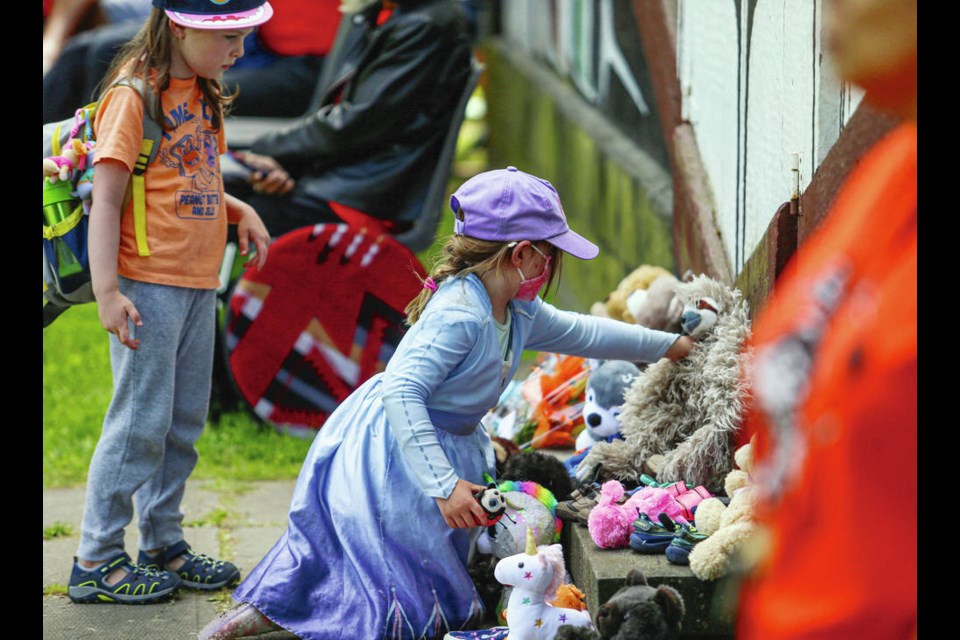Eight-year-old Charlotte Hopkins knelt before a growing pile of plush toys and rows of tiny pink, purple and blue shoes.
She bowed her head and placed her own teddy bear there. With her little brother, Ely, and mother Kailey craddling both in an embrace, they spoke softly for a few moments, remembering the 215 Indigenous children who had died decades before at a Kamloops residential school.
Charlotte, wearing her only orange shirt, said: “We are here to understand and show respect … and the orange shows that I remember.”
Hundreds gathered in front of the Wawadit’la, Mungo Martin House at the Royal British Columbia Museum, to collectively mourn and share their struggles to cope with the grim discovery of children’s remains on the grounds of the former residential school in Kamloops.
Elders openly wept and held each other. Others shed tears in silence or stood deep in thought as drums played and cleansing sage smoke drifted into the air.
Young families, business people, seniors and youth joined in quiet conversations or just bowed their heads.
First Nations from every corner of the Island later gathered armfuls of the little shoes and teddy bears for a candlelight vigil at the legislature.
Shantelle Voyegeur, standing under the shade of a big fir with four family members, held a sign with a stark message: “Does your school have a graveyard?”
“My dad is a residential school survivor from Alert Bay, and he couldn’t bear to be here, so I am here to show my respect,” she said.
Voyageur, of the Kwakiulth Nation, made no apologies for her blunt sign, saying: “I know there needs to be more statements made, and more people are finally paying respects.”
Alert Bay was one of five residential schools on Vancouver Island operated by churches and sanctioned by the federal government in an effort to assimilate First Nations children.
Canada’s residential school system, which was established in the 1880s and continued for more than century, saw about 150,000 Indigenous children removed from their homes and warehoused in dormitories and classrooms.
The Truth and Reconciliation Commission has so far recorded about 2,800 who died while in the system, but estimates say number is closer to 4,200.
Children suffered beatings, diseases, sexual abuse and daily humiliation, as well as a complete disconnect from their own culture.
There have been 202 recorded deaths at the five Island schools, but elders believe that number is much higher. They feel the deaths almost certainly continued as former students traumatized by abuse died by their own hands or through violence.
Bernadine Mawson, a Coast Salish elder, said she and her two brothers attended Kuper Island residential school. The discovery in Kamloops opened fresh wounds.
“It affected us all, and then people didn’t believe us,” she said. “It’s too bad they have to find bodies. Our people are hurting. We have gone through this all our lives, and people wonder why we have problems? This is where it started.”
Leah Wishanski, who brought her children, ages 5 and 2, to the vigil, said she attended to pay her respects and listen. “I really wanted to show that these children are not forgotten,” said Wishanski.
Hopkins said they discussed the discovery at Kamloops with her children, ages 8 and 4. “It’s important my children have an understanding of the history of their country,” she said. “What happened in Kamloops happened to children their age.”
Mera Faith, a member of the Beecher Bay First Nation, brought her four-year-old daughter to the vigil. She was teaching her little girl about “the pain of loss and the truth.”
“It’s important everyone knows the real history of this country,” she said.
Alana Johnson of the Haida Nation drummed and sang with her mother, Ruth Parrish, as Johnson’s daughter, 18-month-old Naaskwa, stood at their feet.
Johnson said she’s run the gamut of emotions over the past four days, from anger and grief to “just being numb.”
“But I’m happy this ceremony is happening,” she said.
Johnson said the secrecy surrounding the Kamloops deaths was infuriating and news of the burials, hidden for so long, only brings fresh pain for residential school survivors.
She wants the federal government to start ground-penetrating radar at every residential school property in the country, and to schedule those in an organized way so people can be prepared for results.
Judith Sayers, president of the Nuu-chah-nulth Tribal Council which represents 14 First Nations in three regions on the Island, demanded governments and churches support the Kamloops First Nation with financial, emotional, spiritual and educational support “to put these children to rest in a good way.”
She said governments and churches must work with First Nations to discover the truth around other residential schools, using ground-penetrating radar to find any other burial sites.
“We cannot rest until this is done,” said Sayers. “We cannot bring the lives of these children back, but we can recognize and educate on the truth of these horrific practices at residential schools and work on current education practices that nurture and teach our children in ways that build their esteem and worth.
“Every child matters.”
Nuu-chah-nulth vice-president Mariah Charleson said many Nuu-chah-nulth children travelled far from their homes and families to attend Kamloops Indian Residential School.
“My heart goes out to every person impacted by these schools,” said Charleson. “This discovery is a reminder to all the survivors of the truth that they are forced to live with daily.”
Charleson said although Canada’s mandate to assimilate First Nations failed, “the legacy is still alive in each of us.
“Let’s commit to healing; I believe our land and teachings as Nuu-chah-nulth-aht will be instrumental in this.”



